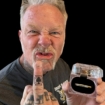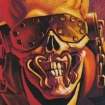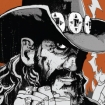Get Motörhead vinyl, apparel, action figures, mini guitars and more at Revolver's shop.
Back in 1974, Ian "Lemmy" Kilmister was playing bass for the legendary British space-rock outfit Hawkwind, who had hired an American expatriate named Joe Petagno to create a series of life-size "space-warrior" designs for record store promotional displays. Petagno and Lemmy hit it off instantly. "We immediately got along like a house on fire — or better yet, a city," Petagno tells Revolver. "He told me he was starting his own band called Bastard and he needed a logo. Something in-your-face and American outlaw biker-like."
Lemmy soon changed the name of his band to Motörhead and recorded an album in 1976 called On Parole, but United Artists was less than thrilled with its contents, a mix of hard rock and proto–speed metal that had little in common with the label's proven cash cows — Kenny Rogers, Traffic, and War. When 1977 rolled around and Motörhead still didn't have an album out, Lemmy set up what was to be a final show at London's Marquee Club and asked Ted Carroll, the co-founder of Chiswick Records, to record it. Instead, Carroll gave them the studio time to record what would become the band's self-titled debut. By this time, Lemmy and Petagno had Motörhead's visual icon in place, and the now legendary "Snaggletooth" was unveiled for the world to see.

"It was pure artistic inspiration, a figment of my imagination," Petagno says of the fanged metal beast that has since appeared, in one form or another, on the cover of almost every Motörhead release over the past 30 years. "I went to the library — remember them? — and did some research on skulls. I was thinking of the Hells Angels logo and thought I needed a skull as a starting point. In the end, I decided a hybrid gorilla-dog-wolf skull with three-dimensional boars' teeth would work nicely with some chains, spikes, etc."
And work it did. "Lemmy and the guys freaked — they were totally sold," Petagno says enthusiastically. "The record company shit a brick because it was just far too violent an image for the climate of the day. I mean, you couldn't get into a decent hotel wearing a Motörhead T-shirt, and you were often asked to vacate pubs if you were wearing one."
Petagno originally did two versions of Snaggletooth — one futuristic, one primal. "The band liked the more primal approach and asked me to give it some spit and a crack or two," the artist explains. "From start to finish, I think it took about eight or nine days, including the lettering, which was changed from 'Bastard' to 'Motörhead.'"
The original piece was done on illustration board with India ink and gouache, a water-based pigment, using only black-and-white coloring. Petagno employed pen, paintbrushes, and an airbrush to achieve the desired shading and highlights. The finished piece measured 24 by 32 inches and is still in Petagno's possession.
In the decades since Snaggletooth's initial incarnation, Petagno has recreated the iconic mascot hundreds of times. "It's always exciting to challenge yourself by trying to come up with a new take on an old subject time after time and still keep it interesting," he observes. "I think the reason I have managed it successfully for so long is simply because Snaggletooth is an integral part of my own personality, so much so that I paint versions of it for pure pleasure and have a lot of Snaggletooth art that no one has seen. Snaggletooth and I are one and the same, really. It's a reflection in the mirror, so to speak. So if it works on a commercial level, that's just an extra bonus!"












